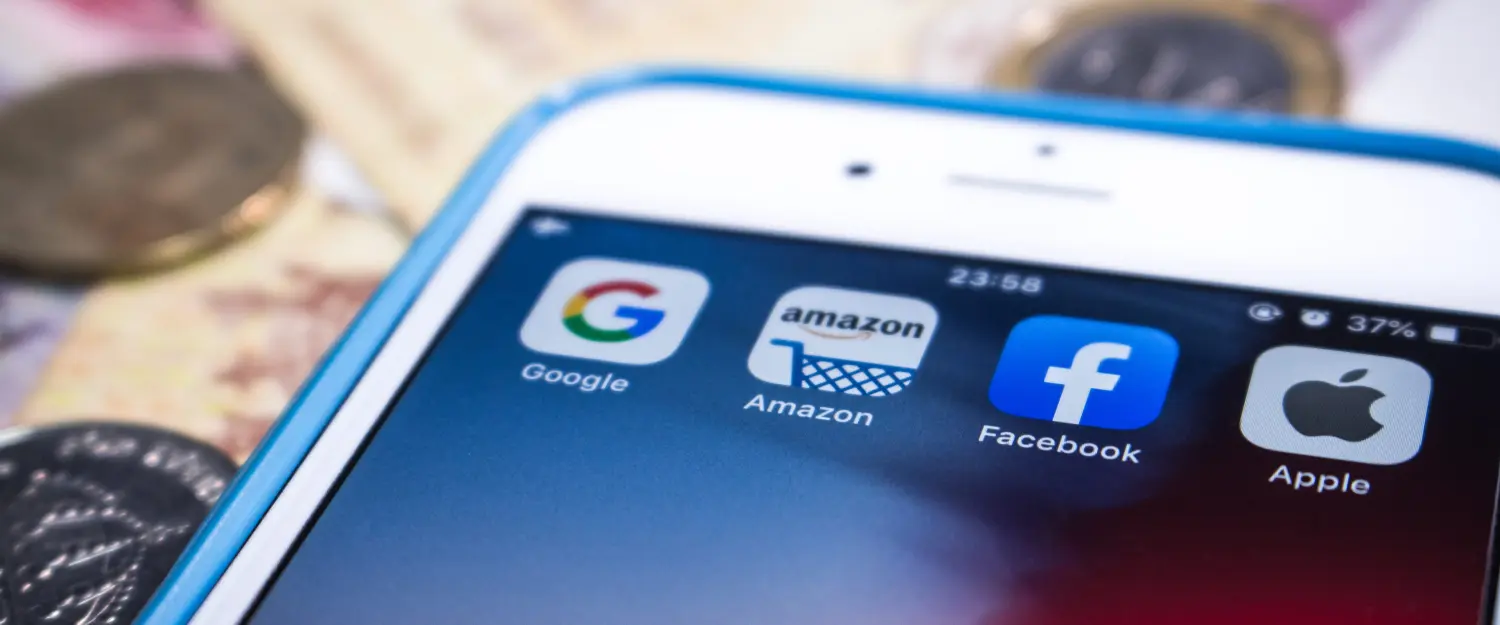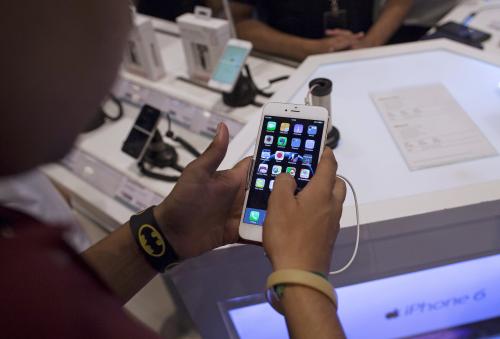As COVID-19 spread and pushed individuals to reorganize their lives around social distancing and personal safety, many people were forced to rely more on technology. Working from home increased dramatically, and with it the need for steady internet access, virtual private networks (“VPN”s), and new platforms where colleagues, managers, and clients could communicate in lieu of face-to-face meetings. Children who were no longer able to attend school in-person used tablets and computers to learn remotely, and educators relied on novel digital resources to support those education efforts. Millions of Americans ordered their groceries from apps, borrowed e-books from their library, and shared holiday meals with relatives thousands of miles away over streaming video. Technology became a deeper and more integral part of people’s lives.
These deeper ties between individuals and technology generated mixed effects and perhaps even more mixed feelings. Some research suggests that working from home staved off an even more calamitous economic collapse, but also could have slightly hampered productivity in certain cases. Remote learning slowed the spread of the disease but is generally considered to have set students back in their learning curve, particularly students in poorer areas.1The realization that you could more easily and regularly see people geographically distant from you was coupled with the realization that these interactions might be far more shallow than traditional face-to-face meetings.
These and other conflicting reactions to the pandemic lead to the question: How has this pandemic-era increase in technological reliance affected people’s view of technology itself? The question is important because public opinion can ultimately sway technology policy, either by increasing demand for new innovations and support of public-private relationships on one hand, or by calling for increased regulation and oversight on the other.
Over the past 5 years, we have conducted a study on public confidence in American institutions in part to answer questions like this. The American Institutional Confidence poll (“AIC”) is a nationally representative panel survey asking respondents about their confidence in different institutions, as well as their general support for democracy and various democratic norms. Over this time, we have had the opportunity to ask individuals how they feel broadly about technology’s role in their life and their confidence in particular tech companies. In doing so, we discovered a marked decrease in the confidence Americans profess for technology and, specifically, tech companies—greater and more widespread than for any other type of institution. In the remainder of this piece, we document this precipitous drop in faith between 2018 and 2021, illustrate where it came from and was most heavily concentrated, and discuss why it matters.
The AIC poll and declining institutional confidence
For the results we describe below, we rely on a two-wave panel survey in which the same respondents were interviewed twice: first pre-COVID in June and July 2018 and then in the midst of the COVID pandemic in July-October 2021. Both waves were conducted by YouGov and included both a nationally representative sample and additional samples of particular populations of interest. In 2018, we supplemented the representative general sample of 3,000 respondents with oversamples of 800 Black Americans, 800 Latino Americans, and 800 Asian Americans, bringing the total size of the survey to 5,400 respondents. In 2021, we re-interviewed 2,370 of our 2018 respondents.2 To make up for panel attrition, the 2021 survey added 400 new respondents from each of our three over-sampled racial groups, as well as an additional nationally representative sample of 500 new respondents. This brought the 2021 poll to 4,070 respondents in total. In our analyses, the results in both waves are weighted to match the Census Bureau’s most recent American Community Survey on key variables.
In each survey, we asked respondents about their levels of confidence in a host of American institutions, as well as their personal policy preferences, their views on the direction of the country, their support for particular democratic norms, their use of social and traditional media, and a wide range of other questions.
We chose institutions that represent the backbone of the country and with which most people are likely to be familiar. From the political side, this included the executive branch, Congress, political parties, and the like. For more personal, day-to-day relevance, we chose banks, colleges, religions, nonprofits, and other similar institutions. As technology is more difficult to represent with any one or small group of institutions, we decided on three main companies to represent the sector. We chose companies that represented different types of technology and that were famous enough that many people would have a meaningful opinion about them: one retailer (Amazon), one search engine and software/hardware conglomerate (Google), and the dominant social media company as determined by the number of users (Facebook).3 In the 2021 survey, we added Twitter.4
Analysis of our surveys yields one immediate and overarching finding: Americans are losing confidence in institutions of all shapes and sizes. As Figure 1 illustrates, the average level of confidence in every institution dropped between 2018 and 2021, in some cases quite dramatically.5
 Figure 1 compares the mean (weighted) confidence on a 1(low) to 4 (high) point scale of a series of U.S. government, nonprofit, and commercial institutions in the 2018 and 2021 American Institutional Confidence Polls.
Figure 1 compares the mean (weighted) confidence on a 1(low) to 4 (high) point scale of a series of U.S. government, nonprofit, and commercial institutions in the 2018 and 2021 American Institutional Confidence Polls.
But digging only slightly deeper reveals that technology companies have experienced the steepest drops during this time period. In Figure 2, we sort the institutions by the percentage of confidence lost in these three years. The three technology companies we asked respondents about (Facebook, Amazon, and Google) dominate the list, with each experiencing a loss of between 13% and 18% of the mean confidence expressed by those surveyed. For Facebook, this loss moved them from the third-least trusted institution in 2018 to the least trusted in 2021 of all institutions on both surveys. Amazon and Google, previously well-respected institutions (the second and fourth most-trusted in 2018, respectively), dropped the second and third-most by percentage and ended up closer to the middle-of-the pack in 2021. Twitter, which we asked about only in 2021, actually rated below Facebook in average level of confidence and was the lowest-scored institution out of the 26 we asked about in either year.

Figure 2 compares the sample-to-sample percentage loss in mean confidence of a series of U.S. government, nonprofit, and commercial institutions between the 2018 and 2021 American Institutional Confidence Polls.
Where does this drop come from?
A natural response to seeing this data is to ask why this should be the case and who exactly is losing the most confidence in these tech giants. In order to investigate these questions at a broad “technology” level, we created a single score for each respondent that aggregates their feelings toward the three repeat institutions (Amazon, Facebook, and Google) in each year as well as the difference between these two numbers for those respondents who participated in both surveys.
At a high level, it should first be noted that every sociodemographic category we examined—and we examined variation by age, race, gender, education, and partisanship—saw its mean confidence in the three tech companies collapse between 2018 and 2021. To put another way, there was not a single demographic group we examined in which confidence in the tech companies increased from 2018-2021. This is particularly striking because the 2018 survey was only two years after the 2016 U.S. elections, which we might have thought would have already caused a drop in popularity for social media platforms like Facebook because of claims of election interference. The 2021 survey, on the other hand, was well into the pandemic, which we would have thought would increase support for companies that brought people goods (Amazon) and information (Google) during a crisis. In sum, our expectations were that trust in technology was already depressed in 2018 and then would have risen by 2021, especially for Amazon and Google, but that is not what we found.
That being said, there are important differences across these sociodemographic groups. When we cut our panel sample into age quintiles, for instance, we see that the youngest 20% of our sample lost confidence at a much greater rate than any other age group. This is particularly interesting given that this group has never experienced an adulthood without these three institutions or the omnipresence of digital communications technology more broadly.
While both Black and Hispanic respondents reported decreased confidence in the tech giants, their drops were not nearly as large as the drops for both white and Asian respondents as well as our other/multiracial respondents. Perhaps the starkest difference is across the political divide. Republicans as a group reported that their confidence in tech companies dropped at a level that was more than 50% greater than the drop reported among Democrats, with Independents in between.
On the other hand, the size of the drop by education has a fairly limited range between the six education categories we used; there is no evidence that additional education systematically increases or decreases the change in confidence in our three tech companies.6 Similarly, male and female respondents had very similar average drops in confidence. However, our small group of respondents who identified as neither male nor female reported a much steeper decline in their confidence—the largest of any of our demographic groupings. While this represents only 47 panel members, it is perhaps reflective of a world where technology and social media has exposed some minority groups to new and sharper forms of bullying.
We know that many of these sociodemographic categories have large degrees of overlap and that we can miss small or large relative effects when looking at any one in isolation. For that reason, we conduct a multiple regression analysis that predicts a respondent’s 2021 tech confidence score using as predictors their 2018 confidence score, each of our demographic categories, and their answers to a few additional questions to our surveys. These include two questions from 2018 asking respondents whether they believe technology would make American society or their lives much better or worse over the next ten years, whether they report being more or less satisfied with life in 2021 (as compared to 2018), and their level of social media use. The effect tied to each level of a sociodemographic category can then be interpreted as how much more or less confidence in 2021 we would expect a respondent to have compared to a respondent that shared the rest of that respondent’s attributes and starting level of confidence in the 2018 survey, but was in the baseline category for that particular sociodemographic category.7
Figure 3 presents some of the key outputs from that analysis, many of which, as would generally be expected, are quite similar to the simple demographic breakdown of findings we have reported in the paragraphs above.
 Figure 3 presents the results of a regression analysis predicting the level of 2021 tech confidence from a respondent’s 2018 confidence, socio-demographic attributes, and survey answers. The baseline categories for socio-demographic groups are: 18-29 (Age), White (Race), Democratic (Partisanship), No High School (Education), and Male (Gender).
Figure 3 presents the results of a regression analysis predicting the level of 2021 tech confidence from a respondent’s 2018 confidence, socio-demographic attributes, and survey answers. The baseline categories for socio-demographic groups are: 18-29 (Age), White (Race), Democratic (Partisanship), No High School (Education), and Male (Gender).
All age groups are significantly more confident in our sampled technology companies than are the youngest respondents (18-29 is the base category in our regression), but they are not significantly different from each other. This suggests that the youngest generation is the least optimistic about the role that technology can play in the world and that we might expect further declines in confidence as teenagers age into our sample and older individuals (the most confident) age out.
When we consider the race of our respondents, white individuals (the baseline/omitted category in our model) are the racial group that is least confident in the three tech companies, save for respondents who identified as multi-racial or as some race other than our main four groupings. Interestingly, there doesn’t seem to be a meaningful difference between Asian, Hispanic, or Black respondents.
Education presents a somewhat more complicated story: Any schooling past high school is associated with less confidence than that reported by high school grads or those who never finished. However, within college or post-graduate students, there is no clear direction of effects.
Gender also presents a mixed story, with respondents identifying as female slightly more confident than males in our tech companies, but the substantive magnitude of this difference is quite small. Those identifying as either non-binary or neither male nor female, however, are vastly less confident, though our results only reach significance at the 0.10 level, given the paucity of such respondents in our panel.
Beyond demographics, other surveyed personal attributes follow expected patterns. The partisan split we observed in the descriptive results reported previously is replicated, with Republicans and those who identify neither as Democrats nor as Republicans losing far more confidence in tech companies than Democrats. Occasional and heavy social media users are more likely to report improved confidence in tech companies, suggesting that familiarity is not the source of contempt in our data. Moreover, while those who report a positive change in their overall life satisfaction are only becoming moderately more confident in tech, those who think technology will make either their personal lives or American society more broadly worse off report significantly less confidence in tech companies than those who tend to think technology improves lives.
In the full picture, while the decline was widespread, being younger, white, more educated, more conservative, and more technophobic and tech-avoidant all are associated with an even greater drop in confidence in the technology companies we examined. These attributes cover a wide swath of the American populace, in ways that can be self-reinforcing or self-canceling in specific individuals. Understanding and responding to these dynamics is increasingly important in a society where reliance on technology grows daily.
What does it mean?
These results are part of a growing consensus among polling organizations that the public’s support for the technology industry is slipping badly. A series of polls from Public Affairs Council and Morning Consult have also found falling trust levels in the technology industry. They found that tech fell from the top spot to sixth among industries in their rankings, and more than twice as many people found the tech industry less trustworthy than other industries as those finding it more so. What is new in our data is the ability to contextualize this drop in popularity relative to other U.S. institutions, and what we find is that not only are tech companies less popular than before the pandemic, but the extent to which their popularity is dropping exceeds the drop in confidence in any of the other U.S. institutions that we examined.
This drop in trust is likely at least partially due to perceptions of how tech companies use and secure private information from individuals. A Washington Post-Schar School poll revealed that large percentages of respondents held almost no trust in tech companies, particularly social media companies, to protect their private data and that they routinely took steps to stop what they saw as unnecessary intrusion into their privacy.
This view of tech as a collection of over-encroaching behemoths is common. A representative poll from The Verge in 2020 found that a majority of respondents believed that tech companies had grown too large, that most were in favor of breaking up tech companies that controlled too much of the economy, and that Google and YouTube in particular should already be separated.
Many of these findings are conditional (a CivicScience poll, for instance, finds that trust in companies’ willingness to protect its users data is strongly determined by age and social media use), and there is likely to be high variance across tech companies (as suggested by this Insider Intelligence piece). Yet, alongside our findings, these other reports paint a picture of an industry with very real trust issues. Tech companies may not be the only companies in which America is losing faith (consider this poll from Pew showing that anti-corporate sentiment is rising), but they are certainly at least close to the head of that pack.
One may be inclined to dismiss the importance of this fact. After all, many of the companies we are focusing on are gigantic in size, controlling large chunks of an economy that is at least partially reliant on them. Amazon is not only the world’s second-largest retailer (behind only Walmart) but also the dominant vendor for cloud infrastructure services, one of the backbones of modern economic infrastructure. Google search is at least five times bigger than all of its competitors combined, and, in YouTube, the company owns the largest video hosting platform. Despite all of its struggles over the past five years, Meta/Facebook remains the world’s largest social media company, reaching nearly 50% of the world’s internet users. Negative shifts in public opinion will not significantly change this landscape for companies in the near term.
But there are still reasons for these companies to be concerned; one need not look farther than Twitter over the past year. While never nearly as large as Facebook, Twitter could plausibly claim that it was the second-most popular social media site and that it had a particular cache with a desirable set of users: the young, the educated, and the political and cultural elite. The company was sold for $44 billion dollars, and while not even its buyer thought it was that valuable (Elon Musk famously tried to back out of a signed deal to purchase at that price), it presented as a fairly stable, large tech company of the type this article concerns.
Fast forward less than year since the purchase was finalized. The combination of Musk’s own public denigration of the company’s main product and developers alongside changes to how accounts are deemed “verified” has led to the loss of millions of users and a stable of long-time advertisers. While Twitter’s specific situation is unusual, it still raises the concern that small shifts in the amount of public trust in these institutions can quickly metastasize into meaningful losses on the business side.
There are also regulatory downsides to slipping public confidence. To this point, most large tech companies have used large stables of lobbyists and lawyers, buttressed by positive public opinion and claims of providing a public service, to escape many forms of governmental oversight. While the lobbyists and lawyers remain, chipping away at public support opens companies up to larger and more consistent attacks on the regulatory end. Even if attempts at regulation are ultimately unsuccessful, fighting them with resources is certainly more costly than doing so with popular goodwill.
Finally, the drops in American confidence may be merely harbingers of wider shifts across the globe, where these companies already operate and where the majority of their future growth is expected to arise. In a special report addended to their annual Trust Barometer, Edelman found that while technology remained the most trusted industry, 14 of their 22 sampled markets around the globe had reported drops in trust in tech companies since the year previous.8 While the U.S. experienced the largest drop, it was followed closely behind by most of the advanced democracies. In these countries, respondents also reported adopting new technology at a much lower level than in countries where tech confidence was higher. This is deeply problematic for companies whose rare new innovations require large-scale adoption to be profitable.
Recognizing there is a problem and taking affirmative steps to solve that problem are naturally two different things. While our work and the similar reports mentioned above identify a real threat to the tech sector and shine a light on places where that threat is the most concentrated, it is ultimately up to the companies themselves to determine why confidence is deteriorating and how to address it. Some potential explanations for the drop, like a backlash against our reliance on their services, are difficult to respond to, and companies may need simply to adapt to these trends and digest the consequences. But others, including confidence losses due to data breaches or actions by tech companies that seem to privilege profits over consumer well-being, are places where companies may need to readjust their balances if they want to thrive or even exist in the long term.
Our findings above perhaps should be taken as a cautionary tale for Large Language Models (LLMs) generally and ChatGPT specifically.9 New technological advances—especially when given away to consumers for free—have clearly enjoyed honeymoon periods of popularity in the public’s eye. But declining confidence in Facebook, Google, and Amazon is a good reminder that these honeymoons often come to an end. Moreover, given the magnitude of the drops we saw from 2018-2021, it is worth asking whether the new players in tech in the 2020s may see their honeymoons end even quicker than their compatriots who rose to prominence a decade or two earlier.
Joshua Tucker was paid as a consultant to design the American Institutional Confidence Poll in 2018. Other than the aforementioned, the authors did not receive financial support from any firm or person for this article or from any firm or person with a financial or political interest in this article. The authors are not currently an officer, director, or board member of any organization with a financial or political interest in this article.
-
Footnotes
- See, for example, Lichand, Guilherme, Carlos Alberto Doria, Onicio Leal-Neto, and João Paulo Cossi Fernandes. “The impacts of remote learning in secondary education during the pandemic in Brazil.” Nature Human Behaviour 6, no. 8 (2022): 1079-1086 and Klosky, Jill V., Julie A. Gazmararian, Olivia Casimir, and Sarah C. Blake. “Effects of Remote Education During the COVID‐19 Pandemic on Young Children’s Learning and Academic Behavior in Georgia: Perceptions of Parents and School Administrators.” Journal of School Health 92, no. 7 (2022): 656-664.
- We attempted to recontact the 5,400 original respondents. Those who were not reinterviewed were not because of two types of panel attrition: either they had dropped out of YouGov’s panel entirely between the times of the two surveys or they were still officially in YouGov’s panel but YouGov was unable to recruit them to participate in this particular survey.
- It was this interest in asking people questions they could understand and about companies of which they had heard that led us to call Google and Facebook by their more widely known names instead of by their official corporate names, Alphabet and Meta.
- Due to space constraints, Twitter was not included in our original 2018 list of technology companies because its product was (and is) much less widely used than the three companies we did include. See, for instance, Auxier, Brooke, and Monica Anderson. 2021. “Social Media Use in 2021.” Pew Research Center, https://www.pewresearch.org/internet/2021/04/07/social-media-use-in-2021/. However, in the aftermath of the 2020 U.S. elections we decided to add Twitter to the second wave of the survey.
- In this report, all sample-wide averages are weighted to be representative of the general U.S. population.
- The drops in confidence between 2018 and 2021 in different racial and education categories are always statistically significant at conventional levels. However, the differences in the magnitudes of the drops across these different categories are not always statistically significant. See Figure 3 and the ensuing discussion of it for a description of which differences across categories in the magnitude of the decline are statistically significant.
- The baseline categories for sociodemographic groups are: 18-29 (Age), White (Race), Democratic (Partisanship), No High School (Education), and Male (Gender). More technically, since we are controlling for level of confidence in 2018 in the regression, the coefficients from the model (presented in Figure 3) can be interpreted as the effect of the given variable on the change in confidence in the tech companies as compared to the omitted category in the category (e.g., compared to the youngest respondents for age, White respondents for race, male for gender, etc.). So, for example, all of the age groups had a smaller drop in confidence (technically, their change in confidence was “less negative” than the change in confidence for the baseline category, which is why the estimates are to the right of zero, even though all age groups saw a drop in confidence) than our baseline category, which here is 18-29 year-olds. However, the difference between the other age groups in terms of drop of confidence appears minor.
- https://www.edelman.com/sites/g/files/aatuss191/files/2022-10/2022 Trust Barometer Special Report_Trust in Technology Final_10-19.pdf. See page 8.
- In a future wave of the American Institutional Confidence Poll, as it becomes more widely known among the mass public, we plan to include questions about confidence in ChatGPT and the company that invented it, OpenAI, which has been the biggest story in tech in the past year. ChatGPT may be the “next big thing”, which, along with TikTok, could threaten the status of all three companies we have examined in this report, perhaps further fueling a decline in public confidence in Google, Amazon, and Meta.









